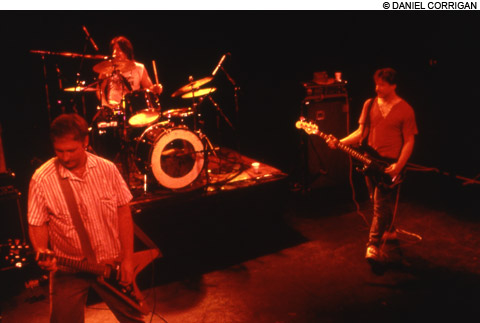
Physically anomalous, emotionally centrifugal. Hüsker Dü evolved at terrifying speed, throwing off great songs in chunks, each album an epoch. |
"Readers of this book will be disappointed," declares Andrew Earles, rather sternly, in the introduction to his Hüsker Dü: The Story of the Noise-Pop Pioneers Who Launched Modern Rock (Voyageur Press), "if they hope to be rewarded with the gritty details of any band member's drug use." Needless (needle-less?) to say, the author is as good as his word, and this reader was duly disappointed. An army marches on its stomach, and a band runs on its drugs. Not to discount the Muse, the state of the culture, etc., but who's on what when: that tends to be the crux of the matter. So in the case of Hüsker Dü might it not be worth knowing, for example, that a gram of crystal meth got tipped into the studio coffee pot for the Zen Arcade sessions? Or that Bob Mould was drunkenly free-associating when he recorded the furry-tongued vocals for "Perfect Example"? I think it might.
For these latter insights we are indebted to Mould's memoir See a Little Light: The Trail of Rage and Melody, which tells the Hüsker story with a depth and texture that was clearly not available to Earles. "People who saw me scowling and lurching around the stage back then," writes Mould, "probably wondered what was going on inside my brain." They certainly did: as a tender 16-year-old I wondered about it often, alarmed by the spectacle of big Bob (quite big in those days) howling himself purple and then blundering sightlessly offstage, almost toppling his amp as he went. "It just felt like loose electricity was flying through my hands and off the guitar," he explains in See A Little Light, "and it sounded like my head was being riddled with pellets of ice — it was almost like being locked in the trunk of a car during a massive hailstorm." So now I know.
Physically anomalous, emotionally centrifugal, Hüsker Dü were . . . but you're still thinking about those pellets of ice, aren't you, and that locked trunk? See A Little Light is full of images like this, their immediacy testifying to the success of co-author Michael Azerrad in getting at the Mouldian essence, the real matter of Mould. Deep we go, into the interior, inside the complex electro-pharmaceutical nervous system from which the distinctive Mouldian frequency emerged. "In the studio I'd started using the unreliable and glitchy Eventide H910 Harmonizer on my guitar to shimmer the sound and take up more stereo space." (This is Bob circa Metal Circus.) "The warbled pitching effect of the Eventide had a very crystalline edge, and the amphetamines I'd now used for three years probably had something to do with why I liked the sound." That sound, that tone, the orchestral, magnesium-edged panic attack of his Flying V — don't you feel you understand it a little better now?